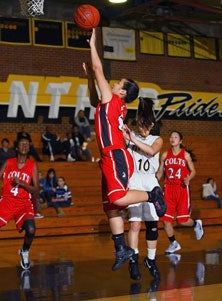Though many are, not all great leapers are born; Three helpful ways to fly to new heights.
In our current social media landscape, it's not too uncommon to suddenly hear about a new star player that had previously only been a role player.

Three simple steps can help athletesimprove their vertical leaps.
Photo by Ernie Abrea
When asked what they did in the offseason to improve the athlete usually responds by saying that they worked out more. In a perfect world, anyone who worked out more and harder each offseason would see such large athletic growth. Yet when we watch the online videos closer, we see that the athlete has attained an awe-inspiring ability.
They can jump a lot higher.
Very few things in sports attract attention and admiration more then an impressive vertical jump. From track and field to a great one-handed catch on the football field to a home run saving catch, the vertical jump is the difference between an athlete that gets all eyes on them and someone hungry for more playing time.
The trouble is that some people are just born with the correct mix of muscle fiber types and muscle insertions that allow them to effortlessly fly through the air.
Sure, Michael Jordan is known for his work ethic and there is no doubt that he worked harder than many people can imagine. But do you really think that the majority of his athletic ability wasn't just there from birth?
So what can the rest of us do to increase our hops? Here's three simple steps to increase your vertical jump in the next four weeks. Every fourth week retest your vertical jump then begin following my recommendations over again.
It is possible for you to jump higher than you ever thought. You just haven't found the right training recommendations until now.
STEP ONEIncrease your hip flexor flexibility.
The Psoas, otherwise known as the hip flexor, functions to pull the knee toward the hip and is the only muscle that flexes the knee above hip more than 90 degrees. Since this muscle is so active daily without us even knowing it, it becomes very tight.
Our body works in opposites, as the hip flexor loosens our glute becomes more active. So what is the importance of our glutes for jumping high? Our glutes are the biggest power producer in our lower body.
Athletes are typically quadriceps dominant, which means they never come close to reaching their jumping height because they aren't using their glutes. Focus on stretching your hip flexor each day, then again before activity.
Start with 30-second holds on each leg once in the morning then once before your sport. Work up to 60 seconds per leg.
STEP TWO
Increase your deadlifting strength.
I'll say it again, athletes need to develop their posterior chain which is their glutes, hamstrings and calves, if they want to jump high. Don't fear the deadlift, it's perfectly fine to do if it's done properly.
Begin with three sets of 10 reps for the first two weeks then perform four sets of six to eight reps.
STEP THREE
Use single leg squats.
I'm not the biggest fan of traditional back squats for scholastic athletes since they end up becoming a strength contest. Start using more single leg squats. Not only do they force you to stabilize on a single leg which is a sports specific movement but you can also perform these movements with a greater range of motion.
This allows your central nervous system to relax, which leads to increased flexibility and greater contraction of all the muscles involved. You just get more work done. Begin with four sets of 12 reps for the first two weeks then work up to three sets of six to eight reps.
That's it. Nothing complicated. Get down to business and you'll love your vertical jump results.
Jimmy Smith, MS, CSCS is a performance therapist and nutritional consultant based in Stamford, Conn. With experience training and consulting with professional athletes from the NHL, AHL and various college and high school sports he incorporates a unique blend of strength training, physical therapy and nutrition in his practice. He offers various online consulting services on his website http:www.jimmysmithtraining.com